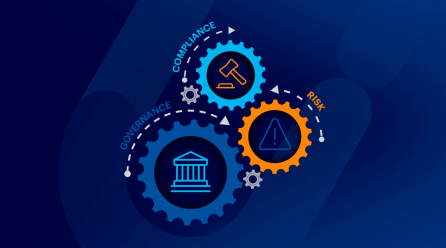Today, the transportation and logistics sector is under immense pressure to meet increased consumer demand while also maintaining a safe and incident-free working environment. This is why embracing an integrated approach to risk management and incident reporting can not only ensure the well-being of your workforce and minimise potential supply chain disruption, but it can also unlock key risk insights to drive decision-making and process improvements.
From the various products & gadgets we use to the food we consume daily; transportation and logistics firms play a pivotal role in bringing them right to our doorstep. With teams and goods on the move constantly – operating across various locations and sites – it comes as no surprise that the sector is prone to a unique set of risks, including high accident rates, theft, stock damage, missed deliveries, and cyber incidents. These can arise from various influencing factors such as human error, adverse weather & climate conditions, poor infrastructure, and substandard IT security.
When it comes to risk management in logistics and transportation industry, there is pressure to meet tight supply schedules, and the lack of resources can greatly tempt organisations to cut corners during busy operating periods. This in turn can often lead to the neglect of proper safety practices and incident reporting. However, a minor health and safety incident can result in financial losses or process delays, while a very serious incident can cause an injury or in the worst-case death of an employee.
In the UK alone, statistics from the HSE show that over a million people are injured or made ill by their work costing £20.7 billion. 135 people were killed in work-related accidents in the space of a year within the UK, 15 of which were in the transport & storage sector. While according to Safe Work Australia, there were 195 workplace fatalities in 2022 with 67 of those in the transport, postal, and warehousing sector. This makes risk management, health & safety, and incident reporting a top priority in this sector. It’s not just the injured employees and their families that will suffer, employers run the risk of facing imprisonment, reputational damage, civil claims, and loss of profits.
This is why it’s vital that risk management and incident reporting are managed comprehensively and fully integrated to understand their relation to one other – which if ignored can leave a huge gap in an organisation’s risk profile.
Discover Camms’ GRC solutions for the logistics and transportation industry.
Why link risk management to incident reporting in the supply chain process?
The synergy between these areas is undeniable, with numerous risks translating into significant incidents and incident causes often finding their way onto the risk register – relevant controls will then be implemented to prevent a recurrence.
Transport and logistics companies that leverage a defined framework under which they map and understand the linkages between their risk register and actual incidents reported can eliminate any potential gaps in their risk management efforts. It can also provide vital insights to guide important decisions around budget & resource activity regarding the prevention of risks and the implementation of safety measures.
Integrating risk management processes with incident reporting can empower businesses to dramatically reduce risk to the business and its people. It enables an organisation to feel confident that employees are following compliance & safety processes and ultimately enhances efficiency and productivity by promoting a positive safety culture.
Disadvantages of Managing Risk and Incidents in Isolation
When an organisation manages risk in isolation, it will struggle to identify which risks materialised into actual incidents. This will create gaps in reporting leaving organisations struggling to make decisions.
Common problems when managing Risk and incidents in isolation include:
- Difficulty identifying which risks materialised into actual incidents.
- Gaps in the risk register as causes of incidents are not added to the risk register and managed.
- A lack of continuous improvement to protect workers from accidents and injuries.
- Uncertainty around where to allocate funds & resources to reduce risks & prevent incidents.
- Risk of non-compliance – as there are many frameworks and standards that stipulate organisations must have integrated processes that consider both the identification and management of risks, reporting, and analysis of incidents.
Because incident reporting provides real-time data on potential hazards ahead of time, forward-thinking organisations can easily leverage these insights to identify potential risks well in advance. This enables them to implement proactive measures and prevention strategies to reduce incidents and drives an enterprise-wide safety culture.
What are the common barriers to effective integration of risk management & incident reporting in logistics operations?
Common barriers that may be hindering risk teams from seamlessly integrating risk and incident reporting processes include:
- The reliance on manual processes such as spreadsheets and emails as the lack of automation and incompatibility between systems & processes will make it challenging to share data seamlessly and facilitate the necessary mapping.
- Inconsistencies in the way data is captured across current risk and incident reporting processes will make it difficult to map the 2 areas.
- Poorly-defined processes can create a lack of buy-in from key stakeholders to mature and integrate the processes.
- Managing risk & incidents in two different platforms or systems will also make it challenging to integrate the 2 areas.
- Departmental barriers – a reluctance to share information, siloed teams and cultural resistance can prevent the sharing of vital data and limit the integration of these functions.
How To Easily Integrate These Two Vital Processes to Mitigate Transportation Risks
Risk teams can easily integrate and automate their risk management and incident reporting processes using the latest GRC technology platforms.
In modern GRC platforms, teams can easily establish a digital searchable risk register that can be segmented into various risk types and categories. Risks are recorded through online forms and predefined workflows govern approvals, escalations, and remedial actions. Online forms are used for conducting risk assessments – seamlessly feeding data into the platform. This methodology ensures the consolidation and automation of the entire risk management process. Teams can establish key risk indicators, monitor risks, and set a risk appetite, operating within clearly defined parameters. The platform facilitates the implementation of a comprehensive control library, enabling teams to conduct control testing and associate each risk with corresponding controls. Each team member is provided with a personalised dashboard, showcasing their outstanding tasks, actions, and key metrics. Dashboards vary depending on role. Lower-level staff will see outstanding tasks related to risk assessments and control checks, middle management will oversee approvals and escalations, and leaders will receive a summary of key metrics to support decision-making.
Within the same platform, teams can facilitate incident reporting based on industry best practices – ensuring uniform data capture for seamless alignment with their risk management programme. Employees log incidents, hazards, or near misses through online forms, with all data directly feeding into the platform. Crucial information such as date and time, involved employees, affected processes, and cost and evidence (including images, URLs, and files) can be logged. Upon incident logging, an automated workflow initiates, escalating the incident and implementing mitigating actions to facilitate resolution. Organisations can customise forms and workflow escalation routes for different incident types. Management can view real-time dashboards & reports – providing insights into the source and causes of incidents – enabling teams to implement proactive measures to reduce recurrence.
The platform’s standout feature lies in its ability to seamlessly integrate these two essential processes. Risks can effortlessly be linked to related incidents, allowing risk teams to develop a more comprehensive understanding of their risk landscape. Leaders can easily analyse how risks materialised, their impact on the organisation, and the time taken for resolution. Teams can leverage combined data to identify gaps in their risk register by examining logged incidents, hazards, and near misses. This helps to identify the common sources of incidents so they can be added to the risk register – ensuring each risk is managed with appropriate controls, thereby reducing the likelihood of future incidents. The entire process operates on full automation, and the standardised data collection method ensures accurate reporting metrics. These comprehensive insights, guide decisions regarding the implementation of controls to mitigate risks and prevent incidents in high-risk areas. Controls can take various forms, including regular checks, new policies or procedures, or new equipment to reduce risks.
The generated data from a combined risk and incident system can guide the organisation on where best to allocate resources and funds based on likelihood and impact if risks logged – considering the finite nature of available resources. It would be impossible for an organisation to mitigate every single risk due to limited resources & funds – therefore, organisations heavily rely on this vital data to make informed decisions regarding control setting and capital expenditure.
The transportation and logistics industry is an essential part of the global economy, and it employs millions of people around the world. By adopting an integrated approach to safety, risk, incident management, and reporting, organisations in this industry can not only protect their workers, their goods, and their reputation, but they can also uncover strategies for operational excellence and informed decision-making.
Are you interested in understanding more about integrating and automating your risk management and incident reporting processes? Simply request a demo of our GRC platform today.Mitigate Transportation Risks





